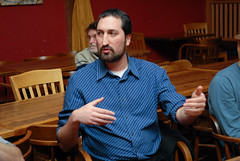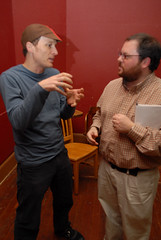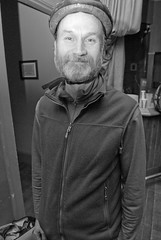
was one of about 50 who showed
up for our second monthly Get Together
event last night.
(Photos © J. Maus)
I think this “Get Together” idea just might have some legs. I honestly did not expect many people to show up, but I was very pleasantly surprised when about 50 people came out to the Lucky Lab in Multnomah Village last night just to talk bikes.
You don’t hear about it as much as inner southeast and other neighborhoods closer to the city, but there is clearly a big, pent-up demand and lots of energy for biking in outer southwest. The turnout last night — both in quantity of people and the quality of the conversations — was a testament to that.
There are many reasons why I’m excited about these events. One of them is simply to get me on a bike to ride in places I don’t usually go. Last night, on my way out to the event I rode on SW Terwilliger to Capitol Hwy (via a scenic loop on Cheltenham, thanks to a suggestion from ByCycle creator Wyatt Baldwin).
Riding on Terwiliger is quite an experience. The bike lane is narrow, cars are going very fast, and there are many sweeping turns. The first thing I noticed was that in those turns, the bike lane striping has completely worn off (and it’s the turns where you really need the paint). I’m sure this has a lot to do with studded tires and all the gravel put on the road during our nasty winter storms.
As I rode along, I wondered about the potential of this scenic and important connection between outer SW and downtown. There’s plenty of right-of-way room on the east side of the road (I was envious of walkers and joggers and their separated, safe space away from cars). Why not just get rid of the southbound bike lane, shift the motor vehicle lanes over, and then create a separated grade, bi-directional bikeway next to the walking path? If we could create a safe experience for bikes, Terwilliger could become a truly exception mobility corridor for all modes.
Eventually — after missing the turnoff to Multnomah Village and going a mile or two down Beaverton Hillsdale Highway (the bikeway route signs failed me) — I made it to the Lucky Lab.
For the first part of the evening, folks settled in with their food (great pizza!) and drinks. I tried to introduce as many people as possible to encourage making new connections and friends but folks hardly needed the help.
As I sized up the attendees (about half of which I recognized), I was really excited to see such a diverse group. The way these Get Together work is very informal. I basically see who shows and then give them a chance to hold the floor and tell everyone about what they’re into and/or what they’re working on.
Last night we had a great line-up — it just so happens that outer southwest Portland is home to a lot of smart and plugged in bike people.
Steve “Mr. Velodrome” Brown kicked things off with an update on his efforts to bring a velodrome to Portland. He shared with us the top locations (PIR, Gateway Green, and Tualatin Hills Parks and Recreation Department headquarters) and then shared his latest idea to work with Merritt Paulson and the push for major league soccer (I’ll have more on that later) as a way to get his velodrome built.
Then Brad Ross took the floor. Brad is the race director of the Cross Crusade and other events and he shared the latest about his upcoming “De Ronde van Oeste Portlandia” race (I’ll have details on this year’s edition soon). This is an underground race that climbs for 10,000 feet in and around the SW hills. Brad told us he wants expand on this idea and work with the City of Portland to officially sign and mark a series of recreational routes in the region. Brad has seen such route networks in Europe and thinks Portland is ripe for the idea. It just so happened that Mark Lear from Bureau of Transportation was also there last night. He had some feedback for Brad and encouraged him to get the idea into the Bicycle Master Plan update.

shared some information about
the CRC project (and no, he was not hassled
about the lane decision).
Zach Horowitz from the Columbia River Crossing project shared the latest about the the bike and pedestrian facilities coming to the bridge.
Bill Alsup shared a bit of info about his two passions — tango dancing and randonneuring. Bill said he and the many other tango lovers in Portland that also bike are planning a tango bike tour in June. He also introduced the crowd to Portland’s long-distance riding and randonneuring scene with info about upcoming events and a plug for the Oregon Randonneurs website.
Portland Police Officer (and Alice Award nominee!) Robert Pickett asked if anyone had gotten a ticket yet for turning right on the new Portland Mall downtown.
After Pickett answered a few questions from the crowd, PBOT’s Greg Raisman and Denver Igarta shared the latest thinking from the city about the future of the bikeway network in Southwest Portland. Igarta brought along a map where people could share their feedback on which routes work for them (and which ones don’t).
The last person to address the crowd last night was Andrew Holtz. Andrew is a member of the Multnomah County Bike and Pedestrian Advisory Committee and he wanted to update us on the need for ideas and feedback on the Scholls Ferry Road re-design project that’s in the planning stages. Holtz said once Scholl’s Ferry is improved for bikes it will “make a big difference” and would let people ride safely between Sylvan and Raleigh Hills (next public meeting on this is April 9).
If that’s not a diverse line-up of bike talk, I don’t know what is.
Another important part of these events is for me to get a better feel for the local issues.
I heard from many people about the need to re-paint bike lanes. Outer southwest has many windy roads and bike lanes get worn off much faster because cars cut the corners. I also heard several complaints about gravel still covering shoulders and bikeways in the area (especially on Beaverton Hillsdale Highway). We also talked a bit about how the bike shortcut through Riverview Cemetery is a “lifesaver” as one person put it (but tread lightly, it’s private property).
I learned about one particular challenge to riding in outer southwest from Kim Isaacson. Kim said that because the area lacks well-defined grid of streets, there are very few alternative routes (and if there are, there’s no signage that would tell someone about them). Therefore, he said, riders are forced to stay on major arterials. Kim said he thinks the solution to this is to make sure all the major streets have a bike facilities on them that are well-marked and connected from place to place.
The event last night was only two hours long, but I felt like we could have used much more time.
Before I left, Lewis and Clark college student Daniel Boyes introduced himself. Ian Stude, the head bike guy at Portland State University was standing nearby. Introducing these two and having them chat about ways that local colleges might coordinate efforts is precisely what this event is all about.
Thanks to everyone that came last night. I hope to keep in touch and return to Multnomah Village soon.
We’re already looking forward to next month’s event. I think we’ll head to East Portland. Stay tuned for location and date.




